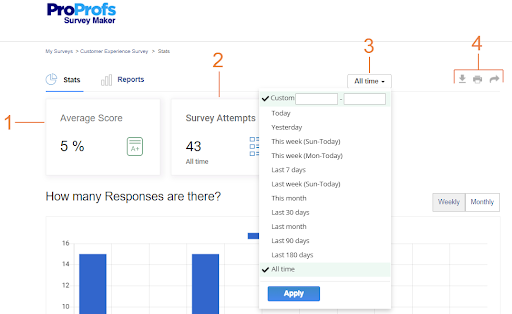
Customer needs are constantly changing.
Today, businesses have no choice but to continue evolving and improving their services to stay afloat and relevant in the market.
But, what bothers most businesses is how to keep a tab on customers’ needs, likes, and dislikes and craft experiences that are aligned to their expectations.
There is one thing that can help you crack the code – online surveys!
Conducting regular online surveys is one of the simplest and most effective ways to unearth customers’ perception about your products, services, and brand.
Before you move forward with creating surveys, it’s crucial to gain a 360° know-how of the several advantages and disadvantages of online surveys. This will keep you well prepared for everything that comes your way during the process.
Dig into this blog to learn all about the advantages of online surveys as well as their disadvantages.
Let’s begin.
Advantages of Online Surveys
Remember when offline surveys were so common that after every purchase, we had to fill forms or even answer questions from marketers over the telephone. Tedious and hectic – both for companies and respondents, isn’t it?
Well, thanks to technology, the way businesses survey their customers has transformed dramatically, making the process much more easy and convenient for both parties.
Let’s now uncover some notable benefits of surveys conducted online.
1. More Convenience & Better Responses
Don’t you love it when you can do things at your own pace in your preferred surroundings? Online surveys provide this convenience to all participants. It allows them to start the surveys when they want and stop whenever it suits them.
Allowing survey respondents to pace up or down as per their convenience leads to better responses. It also allows them to take their time, think things through and share insights that can be of real help to your business.
One of the reasons that many people often skip survey handouts is that they have to complete it right there, and more often than not, they do not have the time for that. Online surveys help businesses overcome this hurdle.
2. Accessibility From any Device
Turn back the clock two decades ago, and you see big clunky computers, a lot of paperwork, and not-so-smart phones. Now, we have phones, laptops, and tablets with powerful specifications that can put an old computer to shame.
Online surveys capitalize on this technological advancement, providing customers the ease of use and flexibility they need to fill survey forms. It doesn’t matter which device respondents use. Just send them the right link via email or text message, and they can access it right away from their device.
Ease of accessibility again points to higher convenience and satisfaction, which further leads to quality responses.
3. Significant Cost-Cutting
Gone are the days when businesses had to break their bank accounts for conducting surveys across different geographic locations.
With the emergence of online surveys, things have changed for good. There is absolutely no expense of hiring an interviewer for telephone or in-person surveys, printing for paper-based surveys, and other related costs.
Since everything is online, you can create a survey and share them with your customers, even those living miles away, at half the cost. Just invest in an excellent survey maker tool, and you are good!
There are plenty of survey tools available on the market that promise excellent results at an affordable price. One of them is ProProfs Survey Maker that offers plans starting from as low as $0.05/response/month.
Pro Tip: Do rigorous research before finalizing a tool. Go for trial versions, compare pricing and features, and then make a call.
4. Flexible With Design
One of the notable advantages of surveys shared online is their design flexibility.
Web-based surveys are not set in stone, meaning you can mold them to fit your changing requirements. Long or short, complex or easy – online surveys can be designed just the way you want. Set up skip logic and branching to provide a well-tailored survey experience. Branching is a great way to show questions based on respondents’ previous answers.
This means questions that are not important for a respondent will be skipped, and only valuable ones will be displayed, guaranteeing a smooth experience. Adding skip logic and branching to surveys make way for more relevant and insightful responses from customers.
Additionally, you can also work on how your survey looks by giving it a logo, theme, background color. An appealing design leaves a positive impact and instantly convinces customers to take your survey.
5. Allows You to be Selective
Not every question in every survey resonates with all your customers. If you distribute a single survey to your customers with varying problems, it’s likely that you will not get the correct responses.
Online surveys are quite flexible that way. They help you pre-screen respondents and survey only those people who meet your specific criteria. Any survey you create can have a few screening questions at the beginning that are meant to determine the respondents’ demographic, purchase behavior, lifestyle, and much more. This makes it easy to qualify or disqualify candidates.
Qualified candidates are then allowed to take the actual survey, ensuring that you get the most accurate data from the right set of customers.
6. AI-Powered Data Analysis
Of all the advantages of online surveys, the one that’s the most beneficial is the easy and quick data analysis. What used to take hours in the case of traditional paper-based surveys now is hardly a matter of minutes.
Data collection and in-depth analysis is a cakewalk when it comes to web-based surveys. If you have the right tool, you can easily view survey results in real-time and get access to valuable insights such as:
- Who took your survey and when
- How people responded to your survey
- The total number of responses received weekly, monthly, and yearly, and a lot more.
These AI-powered insights can set the right base for your future actions. You can instantly gain an in-depth understanding of your customers, spot trends, and make data-backed decisions.

7. Maintains Respondent Anonymity
Another advantage of surveys shared online is the respondent anonymity they help you maintain. If you are looking for honest answers from respondents, this online survey feature is of tremendous help.
When customers come to know about the anonymity aspect, they feel more free and comfortable voicing their concerns and giving true responses with no inhibitions. Anonymous online surveys reward you with genuine and detailed answers that further help you make informed decisions.
Some of the best survey maker tools offer the feature of keeping surveys anonymous, which is great for those who wish to capture some sensitive information that customers would otherwise think twice before sharing.
8. Access to Accurate Feedback
It is common for customers to beat around the bush during in-person or telephonic surveys. Finding wheat from the chaff is another challenging and time-consuming process in such surveys.
Well, with online surveys, you are free from such problems. A key online survey advantage is that it gives you the flexibility to design questions that help you obtain direct and accurate answers from customers.
In addition to this, online surveys do not involve intermediaries such as interviewers or internal staff who capture customer data and then feed it into the system. With online surveys, the process of data collection and analysis is automated, ensuring zero errors in the process.
9. Saves You Substantial Time & Effort
Unlike traditional surveys conducted in-person or via phone requiring you to compile all the responses once the survey is complete, online surveys have no such hassles. They are easy to launch and even easier to analyze. You can do that right from your seat!
While it takes just a few clicks to launch online surveys, customers take not more than a few minutes to submit their responses. It’s a time and effort saver on both sides.
Besides, since there is no printing and manual distribution involved, you can create, publish, and analyze surveys using one integrated system – a big time-saver, indeed!
Create an online survey and watch how it can help you save time in this video.
10. Maximum Reach With Minimum Efforts
Thanks to the emergence of the internet, the big wide world has become compact and connected despite the geographical boundaries.
Suppose you are a multinational company with a customer base across the globe. You want to do a market research survey of thousands of customers residing in different parts of the world. Fifty years ago, this might have felt impossible, but today, you can run such surveys without lifting a finger.
One of the attention-grabbing benefits of online surveys is the heightened convenience they offer.
It doesn’t matter how many customers you wish to survey and which part of the world they live in, web-based surveys can be shared with people across the globe in just a couple of clicks.
The leading survey tools, ProProfs Survey Maker, being one of them, bring you the advantage of creating surveys in minutes and sharing them across platforms most preferred by customers – social media, emails, or websites. You can even translate the survey into the language your customers speak and reach out to a wider audience.
With the right survey software, you can accomplish all of this right from your office desk!
11. Increased Customer Satisfaction
The ease, flexibility, and convenience provided by online surveys are unmatched. While online surveys allow you to share surveys with customers in seconds, they help your customers take up the survey right away or when they have the time to do so.
This gives you access to quick and quality responses that can further be decoded using a survey maker tool.
Online surveys keep you well-equipped and well-positioned to take immediate corrective actions to win back dissatisfied customers and turn the table in their favor.
When you act quickly based on the feedback received, customers feel heard and cared for, and they are more likely to stick to your organization.
Watch this quick video to learn everything about the benefits of online surveys.
Disadvantages of Online Surveys
While there are several advantages of online surveys, there are a few disadvantages as well. Although the pros exceed the cons by a large number, it’s ideal to go through the disadvantages to gain more clarity around the problems you might encounter while working with online surveys.
1. Inability to Connect With People From Remote Areas
One of the major disadvantages of online surveys is their incompetence to reach people residing in far-off, remote locations with no access to the internet. Even elders who do not have internet access and are not proficient in working with online platforms are difficult to connect with using web-based surveys.
2. High Chances of Survey Fraud
In case of lengthy, complicated, or confusing surveys, it’s highly likely for customers to skip questions and respond mindlessly just to get done with the survey. In many cases, people are tempted to fill out the survey in exchange for a reward. Both these scenarios can lead to inaccurate responses and skewed results.
3. Sampling Issues
While conducting online surveys, keep an eye out for sampling issues that might impact the overall results. A representative sample is at the core of a survey that helps you generalize the results for a larger audience.
But there are various sampling issues that can hamper the effectiveness of online surveys. For example, a common sampling error is when researchers are confused about who to survey – those who directly use the product or those who influence the customers.
Another example can be instances where only interested individuals participate in the survey out of their own will. The ideal process should be researchers making extra efforts to get more and more people involved in the survey.
4. Response Bias
Another problem that can lead to misleading information is response bias in online surveys. Most of the time, people tend to respond in a certain way due to various reasons such as:
- the fear of being judged
- Financial situations
- Personality differences, and many others.
For example, in some surveys, customers might be inclined towards options that make them look more socially desirable and financially stable, thus leading to dishonest responses. Sometimes, even the order of survey questions can make people biased towards specific answers.
Another instance of survey bias is when participants are disengaged. As they have no interest in the survey, they tend to choose the last option of most questions, which again leads to unreliable results.
5. Survey Fatigue
Research conducted by Customer Thermometer found that the response rate for long surveys is a meager 9%. Yes, surveys can get tiresome, especially those with open-ended questions requiring deep and careful thinking.
Many times long surveys take more than 10-15 minutes to complete. It induces fatigue in the minds of the respondents resulting in dishonest responses, or even worse, survey dropout.
This clearly shows that long surveys or irrelevant questions are a big disadvantage and a major reason for customers disliking the entire process and most often abandoning the survey in between.
6. Increase in Errors
Since online surveys harness the power of technology, there could be many response errors. The internet connectivity can go low, forcing the respondents to restart the survey repeatedly. Also, there could be device-related issues. For example, if the survey does not display well on mobile phones, the respondent might abandon the survey or give wrong answers due to confusing display.
7. A Large Number of Unanswered Questions
Skipping unwanted questions is as easy as answering questions in an online survey. This means, every time participants get a complicated, long, or irrelevant question, they are highly likely to skip it and move on to a question they are comfortable answering.
The ease online surveys offer can play against you in such scenarios. Customers might leave a lot of questions unanswered, affecting the ultimate survey results and analysis. You can avoid this by creating surveys with relevant and uncomplicated questions.
8. Difficult to Interpret the Sentiments Behind the Answers
There are inarguably several advantages of online surveys – they are easy, convenient, and flexible. But, an important area where they lag behind is capturing what respondents really feel about the problems mentioned in the survey.
Being completely online, there is no way you can notice the facial expressions or body language of the participants. All you have is the responses to decode what customers really feel.
Thankfully, there are sentiment analysis tools like Qualaroo that help you turn random text into organized data. Backed by IBM Watson, the software helps you decode specific keywords and use the analysis to track customers’ mood.
This video is here to demonstrate how Qualaroo works.
It’s Time to Give Online Surveys a Shot
If you haven’t tried online surveys yet, it’s time you do so.
Like traditional surveys, there are pros and cons of online surveys too. Despite the many online survey advantages and disadvantages, one thing is pretty clear, they are far better than traditional surveys conducted in-person or via phone. We all know why – online surveys are easy to create, share, and analyze. They feel less overwhelming to participants, promising a higher completion rate than traditional surveys.
What more? They help you maintain respondent anonymity, save time and effort, cut down costs, and get more done in less time.
On the flip side, online surveys can pose accessibility, sampling, fraud, and other such problems that might impact the results and analysis.
But, if you carefully evaluate, the benefits of online surveys clearly outweigh the disadvantages, and therefore you must give it a try!
Create and launch online surveys with ProProfs Survey Maker and get access to a reservoir of customer feedback!
FREE. All Features. FOREVER!
Try our Forever FREE account with all premium features!







